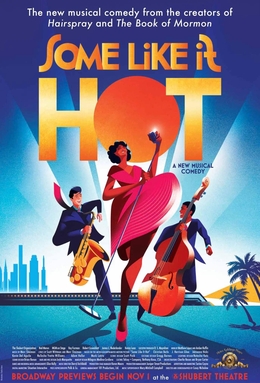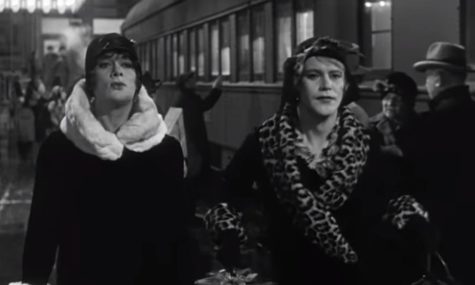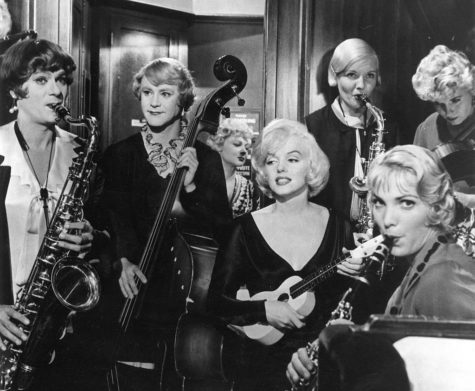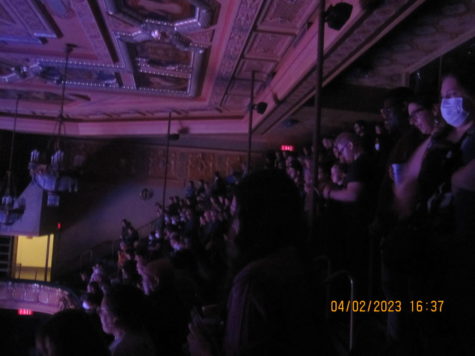Will You Like It Hot? Some Do!
Almost 75 years after the release of the comedy film ‘Some Like It Hot,’ the story has resurfaced, this time in musical form. Does the new show hold its own against the classic movie? And what’s so special about this film that we’re revisiting it now?

Here is the poster for the Poster of the stage musical adaptation of ‘Some Like It Hot.’
The second Sweet Sue stepped onstage, and we were on the edges of our seats, leaning towards her voice. The opening number, ‘What Are You Thirsty For,’ filled the theatre with this buzzing happiness – you could have broken a glass on the railing next to us, and I doubt any of us would have noticed. We were rapt, watching Sue belt with more personality than I thought possible.
In the second number, ‘You Can’t Have Me (If You Don’t Have Him),’ we met our main characters, Jerry/Daphne and Joe. They started singing, and I realized that I was watching my best friend and I, and when I looked around I knew everyone could see their own best friend, too. Jerry/Daphne and Joe in this number were the perfect encapsulation of how it feels to love someone enough that they become an extension of yourself.
Throughout the show, I felt as though I was both watching it and living it. I watched Sugar and Joe’s friendship develop into something more, I watched Sue love her band members with the ferocity of a parent, I watched Jerry/Daphne fall in love with their newfound identity, and as I watched I felt it all – Sugar morphed into my first love and Joe’s face became my own, I was Sue and I was loving my friends as if their lives depended on it. I was Jerry/Daphne, staring at my reflection and grinning at the realization that I didn’t have to be a girl if I didn’t want to be.
Good musicals tell you a story. Great ones make you fall in love with a story. Some Like It Hot throws its audience into a story and lets them forget about the lights and the costumes, letting them experience a masterpiece.

Some Like It Hot didn’t start out as a musical. It started as a French movie called Fanfare of Love, which wasn’t very popular, and it became an American movie called Some Like It Hot, which was. The latter film, released in 1959, is a two-hour slapstick comedy.
The plot has stayed mostly the same from adaptation to adaptation. Two musicians witness a murder and realize that the killers need them dead in order to cover their tracks. They realize that they need to leave the city (and possibly the country) as soon as possible, and after some searching, they find that the safest escape would be joining an all-girl traveling band. The only problem – both of the musicians are men. Low on options, they decide to dress as women and perform with the band until they reach Miami (or, in the case of the musical, California), where they’ll break away to Mexico. Of course, because this is a comedy, things go downhill. Fast.
Some Like It Hot isn’t the perfect queer film by any stretch. There was little awareness of transgender identities in the 1950s, and many people who might identify as trans now could only express themselves through drag, or by identifying as fem gay men or butches.
This isn’t to say out trans people didn’t exist – they did. A few trans people changed their names and socially transitioned, and some even underwent gender-affirming surgery. But socially or medically transitioning was incredibly rare, and it was dangerous.
Sierra Hanrahan ’24, a Bronx Science junior, reflected on the history of trans identities. “Language and labels shift so much, and back then, there was almost no way for someone to express that their gender was different from their sex, or different from how society perceived them. But the feeling was always there.”
With this in mind, trans characters were almost never portrayed on film. When butches, femme gay men, or drag kings and queens were portrayed, they were depicted as perverts worthy only of ridicule. Some Like It Hot doesn’t entirely subvert this trend. There were no explicitly queer or trans characters, and although Jerry/Daphne ends the film by marrying a man who knows he’s a man, it’s played off as something to laugh at. Departure from social norms has always been a part of comedy – we instinctively laugh at the subversive, the odd, and the unexpected, and what was ‘odder’ in the 1950s than a man in a dress.
“I couldn’t really enjoy [the movie] – I wanted to, but it just wasn’t funny to me,” said Hanrahan. “It’s an uncreative joke, and it felt like [the writers] were punching down. I felt like Some Like It Hot relies on the idea that the audience is going to find trans people gross and weird and that’s what we’re supposed to be laughing about.”

Beyond not including openly queer characters, the film version of Some Like It Hot has no characters of color, or at least no important ones. This isn’t too surprising – most films at this time featured predominantly white casts and all-white stars, and films that centered on people of color focused almost entirely on pain – but its lack of diversity takes a lot of viewers out of the movie.
“It’s always odd, watching old movies, because black and white films almost never have Black characters,” said Hoffman.
Despite its apparent lack of diversity, Some Like It Hot is often referenced as paving the way for a future of queer film. The movie was hugely popular from the day it hit theatres, and although that doesn’t seem surprising now – the film seems to encapsulate the comedy of its time – its acclaim changed Hollywood forever.
Years before Some Like It Hot came out, Hollywood, concerned about potential government censorship, had implemented something called the Hays Code. The code was a self-censorship system regulating which movies could be produced in Hollywood – the idea was that without a Hays Code stamp of approval, funding or marketing were almost entirely off the table. Films had to clearly dictate what was ‘right and wrong’ to their audiences, and any character engaging in moral impurity had to be punished within the text. Moral impurity, as defined by Hollywood, included everything from crime to graphic violence to sexual perversion.
“[Have] you ever seen a married couple sleeping in adjacent twin beds in an old sitcom? That’s the Hays Code – sleeping in the same bed was seen as too suggestive,” said Tallulah Hoffman ’24, a junior at Calhoun.
Sexual perversion was a purposefully ambiguous term. Sex acts, or implied sex acts, were banned, but so was any indication of homosexuality or non-gender conformity. The Hays Code was seen as law for over 20 years, and it decimated any hope of queer inclusion in film. Still, the code couldn’t halt progress forever.
“At first, theatres actually refused to play movies that didn’t have Hays Code approval, so the code was functionally mandatory if a filmmaker wanted anyone to watch their movie. But slowly, theatres loosened that regulation. People wanted to watch movies that were a bit sexy, that pushed boundaries a bit, and theatres wanted to capitalize on that,” explained Hoffman.
By the late ’50s, when Some Like It Hot was made, the Hays Code was on its way out. When the film was labeled “seriously offensive to Christian and traditional standards of morality and decency,” director and producer Billy Wilder decided to take a chance and make it anyway. The movie showed drag, implied queerness, drinking, brazen sexuality, and gambling – and the characters that were so ‘morally corrupt’ weren’t textually punished (killed, jailed, condemned, etc.) as the Hays Code demanded. Its popularity was the beginning of the end for the code, which was officially dissolved less than a decade later.

In recent years, remaking old movies and plays has been something of a fad, with live-action versions of animated films and play versions of old movies. Making the old into the new has enticed audiences – it tugs on the public nostalgia for a simpler time, without the bigotry of the era. Reflecting this trend, over half a century after the film’s release, Some Like It Hot (the musical) opened on Broadway.
This isn’t the first time the movie has been rewritten as a musical. The first adaptation, Sugar, premiered in ‘72 and was nominated for four Tony awards. It has been revived since, but it’s made nowhere near the splash that Some Like It Hot (the musical) on Broadway has. Some Like It Hot and Sugar have completely different scripts and scores.
One notable difference between the two is the modern values represented in the more recent show. Writers Amber Ruffin and Matthew Lopez made sure to include central Black and queer characters whose identities are written into the script along with the captivating musical numbers and hilarious awkwardness of the main characters.
Jerry/Daphne is Black, and segregation limits their and Joe’s options when searching for a club to dance for. Joe has an almost flippant attitude towards the discrimination — he’s confident that once people see their talent, they’ll overlook any other concerns they had. Jerry/Daphne is less certain. They are resigned to not getting the spotlight, and being a part of a racially inclusive singing group is exciting to them in a way Joe can’t really conceptualize.
Jerry/Daphne spends a large amount of time in the musical exploring their gender identity. They start the play reluctant to dress as a woman at all, but soon they’re thoroughly enjoying themselves and have started to go on dates with a man. By the end, they’ve come out to Joe as genderfluid and decided to go by both names. Some Like It Hot is an excellent portrayal of acceptance above all else — even though Joe is confused by Jerry/Daphne’s identity, he accepts them wholeheartedly and makes an effort to understand.
This musical is full of queer and Black joy — it acknowledges the hardships associated with those identities but doesn’t get bogged down in accurately demonstrating the oppressive forces of the time. Some Like It Hot has always incorporated magical realism, and this is just another example of that.
“I just loved it. There isn’t much more to say, honestly – I was smiling the whole time, it was funny, it was fun, the songs were amazing… I’d love to go back,” enthused Lehman junior Max Greenhill ’24.
Will you like it hot? Would you like to find out? Tickets to the musical start at $53 each, and the cast will perform eight shows a week for the foreseeable future. If you’re looking for an old-timey comedic musical with modern values, Some Like It Hot is your next obsession.
Good musicals tell you a story. Great ones make you fall in love with a story. Some Like It Hot throws its audience into a story and lets them forget about the lights and the costumes, letting them experience a masterpiece.
Acadia Bost is a returning Editor-in-Chief for ‘The Science Survey.’ Placing an emphasis in their writing on the more structural, long term problems...
